Evaluating the Development Levels of Green Urban Transportation Systems
Abstract
1. Introduction
1.1. Research Background and Significance
1.2. Current Research on Green Transportation Evaluation Methods
- 1.
- The index-construction process is mostly based on quantifiable indicators rather than qualitative/connotative ones;
- 2.
- The tenacity of transportation in the PPE has not been considered;
- 3.
- The selection of evaluation methods has not been closely integrated with the indicator characteristics themselves.
1.3. Research Content
2. Urban Green Transportation Indicator System
2.1. Connotations of Urban Green Transportation
2.2. Connotation-Based Evaluation Indicators
- 1.
- Green and low-carbon composite indicators A (as shown in Table 1):
- (a)
- Energy intensity indicators (e.g., A1, A2, and A3): These indicators reflect the level of comprehensive energy consumption of the urban transportation system. The combined energy consumption per unit of transport turnover by each transport mode equals the vehicle energy consumption per transport mode divided by the vehicle-transport turnover volume.
- (b)
- Carbon-emission intensity indicators (e.g., A4, A5, and A6) [34]: These indicators reflect the level of carbon-emission intensity of urban transportation. The CO2 emissions per unit of turnover by each transport mode equals the CO2 emission volume from vehicles divided by the vehicle-transport volume by transport mode.
- (c)
- Pollutant control indicators (e.g., A7): These indicators reflect the pollution of the environment by urban transportation.
- 2.
- Green transportation infrastructure facility indicators B (as shown in Table 2):
- (a)
- Density of the city bus network (km/km2) (B1): This indicator reflects the proximity of residents to bus routes. It is the length of the urban bus network divided by the urban area.
- (b)
- Bus stop coverage rate (500 m) (%) (B2): This indicator reflects the capacity of bus services. It is the ratio of the 500 m coverage area of public stops in built-up areas divided by the built-up area.
- (c)
- Urban Bus Rapid Transit (BRT) km per 10,000 population (including bus lanes and rail transit) (km per 10,000 population) (B3): This indicator reflects the BRT and rail transit service capacity. It is obtained by adding the BRT and rail transit miles and dividing by the population.
- (d)
- Construction of urban bicycle lanes (B4): This study used the bicycle lane network density divided by the total urban area; indicators such as the bicycle lane width or service radius could also be selected.
- (e)
- Construction of urban pedestrian walkways (B5): This indicator reflects the construction of both general pedestrian walkways within the built-up area of the city and walkways connecting with stations such as urban bus stops and rail transit stations. This study used the pedestrian–facility network density (i.e., the pedestrian trail length divided by the urban area); the sidewalk width and service radius of the fitness trail could also be used.
- (f)
- Urban traffic signal operational efficiency (B6): The efficiency of vehicular traffic at traffic light junctions on urban roads within the built-up areas of cities can be evaluated by using such indicators as the number of traffic signals, average waiting time for pedestrians to cross the street, number of vehicles passing in the peak hour, and delayed waiting time at the junction.
- (g)
- Construction of natural-gas-filling and charging stations (B7): This indicator reflects the ease of vehicle refueling or charging. Indicators such as service radius and floor space can be used for evaluation.
- (h)
- Construction of urban comprehensive transportation hubs (B8): This indicator reflects the convenience of transportation hubs. Parking lot and transfer hub ownership or area can be selected for evaluation.
- 3.
- Transportation equipment indicators C (as shown in Table 3):
- (a)
- The proportion of energy-saving and green operating vehicles (%) (C1): This indicator is the total percentage of operating vehicles that are natural-gas-powered, hybrid, or electric powered. It could be subdivided into further categories, such as private vehicles, buses, and cabs.
- (b)
- Number of standardized buses per 10,000 people (standardized buses/10,000 people) (C2): This indicator reflects the level of public transport development and the traffic structure situation.
- 4.
- Green trip and organization indicators D (as shown in Table 4):
- (a)
- Public transport travel sharing rate (%) (D1): This indicator reflects the degree of public transport priority development; it is an important indicator for measuring the development and rationality of public transport. It is the number of urban residents who choose public transportation (including regular buses and rail transit) as their mode of travel divided by the total number of trips.
- (b)
- Proportion of slow-transportation trips (%) (D2): This indicator reflects the level of development of slow transportation (walking and biking) in the city.
- (c)
- Ratio of full/empty bus routes throughout the day (%) (D3): This indicator reflects the utilization of bus service, the rationality of bus route planning, and the level of operational scheduling. The full load factor is one of the important bases for rationalizing capacity. The maximum line load factor is the ratio of the sum of peak-hour high-one-way, high-cross-section retention to the sum of hourly crews.
- (d)
- Public transport punctuality (%) (D4): This indicator is the proportion of on-time trips.
- (e)
- Cab mileage utilization rate (%) (D5): This indicator reflects the capacity of cab services. It is defined as (total number of miles traveled minus empty miles)/total miles traveled.
- (f)
- Development of shared transportation (D6): This indicator reflects urban shared mobility; for example, the use of carpools, shuttles, and school buses. The proportion of such trips can be used as an evaluation indicator.
- (g)
- Promotion of public bicycles (D7): This indicator reflects the promotion of shared bicycles by city organizations. The shared bicycle ownership and usage rate in the city can be counted as evaluation indicators.
- (h)
- Traffic congestion index/running speed (D8): This indicator comprehensively reflects the smoothness or congestion of the road network and measures travel efficiency and happiness index.
- (i)
- The 10,000-vehicle accident rate (%) (D9): This indicator reflects urban traffic safety. These data are usually available through the city’s statistical yearbook.
- (j)
- Average interchange coefficient (%) (D10): This indicator reflects bus operation conditions, analyzes the degree of passenger satisfaction in different areas according to the passenger transfer coefficient, and measures the convenience and level of bus service. It is defined as the ratio of the sum of ride-sharing trips and transfers to the number of ride-sharing trips.
- 5.
- Energy-saving and environmentally friendly technology application indicators E (as shown in Table 5):
- (a)
- Degree of land use alignment (E1): This indicator reflects the degree of alignment of the green transportation plan with the city’s master plan.
- (b)
- Energy-saving and emission-reduction technology promotion (E2): This indicator includes the application of technology, the development of publicity and training, and energy-saving and emission-reduction monitoring and statistics. The application of energy-saving and emission-reduction technology in the entire process of design, construction, operation, and management can be evaluated.
- (c)
- Application of public transportation-oriented development concepts in urban planning (E3): This indicator reflects the promotion of the “public transportation priority” policy of the city.
- 6.
- Intelligent transportation and informatization indicators F (as shown in Table 6):
- (a)
- Public travel information service system (F1): This indicator represents a platform that includes a public travel service system, a geographic information system, and other components.
- (b)
- Application of intelligent dispatching system for urban public transportation and cabs (F2): This indicator includes the information service system, geographic information system, coordinated dispatching system, and emergency handling system.
- 7.
- Transportation management indicator G (as shown in Table 7)
2.3. Criteria for Defining the Hierarchy of Evaluation Indicators
3. Evaluation Methodology Based on Comprehensive and Integrated Empowerment Method
3.1. Basic Principles and Calculation Steps of the G1 Method
3.1.1. Evaluation of the Determination of Ordinal Relationships of Indicators
3.1.2. Comparative Judgment between Indicators xk–1 and xk
3.1.3. Calculation of Weight Values for Each Indicator
3.2. Basic Principles and Steps of Entropy Value Method
- 1.
- First, xij is normalized. Since the units of measurement of different indicators may be different, it is necessary to remove the influence of the units, which is commonly known as dimensionless processing. In the green transportation evaluation, contains all evaluation scores, so this step may be skipped.
- 2.
- The share pij of the i-th option of the j-th indicator is calculated as
- 3.
- The entropy value ej of the j-th metric is calculated as
- 4.
- The coefficient of variation gj for the j-th indicator is calculated. Subsequently, based on the entropy value of each indicator, the coefficient of variation is calculated. When the original values of each indicator of each program are equal, , then indicator has no role in the comparison between the evaluated objects. In general, the greater the difference from the original value of the indicator , the smaller , and the greater the role of the indicator; the converse is also true [38]. Therefore, the coefficient of variation is defined as
- 5.
- The coefficients of variation are normalized to obtain the objective weights, and the weights of the indicators are calculated as
3.3. “Additive” Integration Method for Determining Final Weights
4. Urban Green Transportation Evaluation and Suggested Improvements
4.1. Example of Evaluation of Urban Green Transportation System
4.1.1. Status of Green Transportation Development in Harbin
4.1.2. G1 Method
4.1.3. Entropy Value Method
4.1.4. Integration Method for Determining Final Weights
4.1.5. Analysis of Evaluation Results
4.2. Suggestions for Further Sustainable Development in Harbin
- Improving the configuration of green transport facilities and equipment. In the PPE, the service capacity of urban green transportation must be improved in terms of safety, efficiency, convenience, and economy. Green travel modes must be integrated into intelligent transportation systems, slow-moving transportation infrastructure and transportation equipment must be deployed (Figure 3), and stronger guidance for green travel must be provided.
- Prioritizing urban public transportation. A public rail and rapid-transit system that is supplemented by other types of regular public transportation, special public transportation, and rental cars must be constructed. For example, the aims of the 14th Five-Year Plan for Transportation in Harbin City include seeking approval from the higher government levels for subway planning, optimizing the layout of public transportation grids.
- Solving the “last-mile” (distance from a rail or bus stop to home) problem. Shared transport modes, including net buses (a mode of public transportation through online reservation services) (Figure 4), online car rentals, time-share rentals, and shared bicycles (a dockless bicycle sharing service based on mobile Internet technology, which provides bicycle rental services through placing bicycles in areas such as subway stations, bus stops and public service areas, etc., and provides bicycle rental services through a mobile APP or related platform) (Figure 5), offer flexible and convenient point-to-point services that improve travel efficiency, reduce walking distances, and help to solve the “last-mile” problem in the interchange process [42].
- Improving transportation resilience and reducing carbon through intelligence and information technology. In addition to active promotion of the universal use of new energy vehicles, various modes of transportation should be integrated through information technology, such as creating a “model as a service (MaaS)” ([43] service platform, to improve the efficiency of travel by reducing aggregation. Moreover, intelligent scheduling (a comprehensive management platform integrating a variety of advanced technologies and functions) (Figure 6) and simulation and forecasting technology [44] should be used to improve traffic resilience in major emergencies.
5. Conclusions
Author Contributions
Funding
Institutional Review Board Statement
Informed Consent Statement
Data Availability Statement
Acknowledgments
Conflicts of Interest
References
- Dai, H.L.; Su, Y.M.; Liu, J.Z.; Gu, D.J.; Kuang, L.C.; Zou, C.N. Reflections on China’s energy development strategy under the goal of carbon neutrality. J. Beijing Pet. Manag. Cadre Coll. 2022, 29, 12–19. Available online: https://kns.cnki.net/kcms2/article/abstract?v=lQz6UQjnwp-2I5W850nfPL4kAHjlZVBjp9WZaFX_r9F4oa-NW6glKDYvxO65ot5XG9kH57khcQG1xZpWJaR6xh82qcBpgOA1gY16jAIJSiIQube8eQvzGE0s4e91_Lln9wY7vGbKk3Tb0EftCoiVjA==&uniplatform=NZKPT&language=CHS%W CNKI (accessed on 20 July 2023).
- National Development Reform Commission of the People’s Republic of China. Opinions of the National Development and Reform Commission and Other Departments on Promoting the Green Development of the Joint Construction of the Belt and Road Initiative. 2022. Available online: https://www.gov.cn/zhengce/zhengceku/2022-03/29/content_5682210.htm (accessed on 3 April 2023).
- Yang, T.; Sun, X.L. Transportation development strategies for large cities under the constraints of climate warming and “dual-carbon” targets. Transp. Harb. Navig. 2021, 8, 3–7. [Google Scholar] [CrossRef]
- Wang, M.L. Research on Comprehensive Evaluation of Green Transportation Based on Sustainable Development Theory. Master’s Thesis, Chongqing Jiaotong University, Chongqing, China, 2016. [Google Scholar]
- Fu, L.H.; Liu, A.H. (Eds.) China Statistical Yearbook; China Statistical Press: Beijing, China, 2022. [Google Scholar] [CrossRef]
- Shah, K.J.; Pan, S.Y.; Lee, I.; Kim, H.; You, Z.; Zheng, J.M.; Chiang, P.C. Green transportation for sustainability: Review of current barriers, strategies, and innovative technologies. J. Clean. Prod. 2021, 326, 129392. [Google Scholar] [CrossRef]
- Chen, J.; Chang, Z. Rethinking urban green space accessibility: Evaluating and optimizing public transportation system through social network analysis in megacities. Landsc. Urban Plan. 2015, 143, 150–159. [Google Scholar] [CrossRef]
- Awasthi, A.; Chauhan, S.S.; Omrani, H. Application of fuzzy TOPSIS in evaluating sustainable transportation systems. Expert Syst. Appl. 2011, 38, 12270–12280. [Google Scholar] [CrossRef]
- Ma, F.; He, J.; Ma, J. Evaluation of urban green transportation planning based on central point triangle whiten weight function and entropy-AHP. Transp. Res. Proc. 2017, 25, 3634–3644. [Google Scholar] [CrossRef]
- Zhu, X.D.; Xue, D.X.; Gao, J.N.; Luo, R.Q. Research on green transportation index system. Urban Road Bridge Flood Control 2019, 10, 156–160. [Google Scholar] [CrossRef]
- Gao, Y.; Ma, Z.L.; Liu, J. Evaluation method of green transportation level in national central cities under the goal of “double carbon”. Transp. Res. 2022, 8, 30–41. [Google Scholar] [CrossRef]
- Yan, J.Y. Research on Urban Comprehensive Transportation Planning under Green Transportation Concept. Master’s Thesis, Zhejiang Ocean University, Zhoushan, China, 2017. [Google Scholar]
- Zhang, Y. Research on Green Fuzzy Comprehensive Evaluation of Urban Green Transportation. Master’s Thesis, Guizhou University of Finance and Economics, Guiyang, China, 2017. [Google Scholar]
- Wang, M.; Lin, X.; Yu, L. Comprehensive evaluation of green transportation in Chongqing main urban area based on sustainable development theory. Syst. Sci. Control Eng. 2019, 7, 369–378. [Google Scholar] [CrossRef]
- Xu, M.M.; Zhu, L.M.; Zhang, S.Y. Research on comprehensive evaluation of green transportation system based on AHP-value function method. J. Jiamusi Vocat. Coll. 2022, 36, 263–264. [Google Scholar]
- Jin, D.; Dong, X. Research on the evaluation of urban green transportation development based on DPSIR model. Ecol. Econ. 2018, 34, 79–85. [Google Scholar]
- Zhang, Z.F. Evaluation of urban green transportation planning based on value function. Transp. Energy Sav. Environ. Prot. 2015, 11, 52–55. [Google Scholar]
- Li, L.; Zhao, X.; Du, X.W. Comprehensive evaluation of urban green transportation development evaluation research. J. East China Jiaotong Univ. 2021, 38, 51–60. [Google Scholar] [CrossRef]
- Jiang, C.; Yin, S.; Yao, Z.; He, J.; Jiang, R.; Jiang, Y. Safety evaluation of mixed traffic flow with truck platoons equipped with (cooperative) adaptive cruise control, stochastic human-driven cars and trucks on port freeways. Phys. A Stat. Mech. Appl. 2024, 643, 129802. [Google Scholar] [CrossRef]
- Zhou, W.; Luo, F.; Wu, X. Jointly Building a Green “Belt and Road” to Promote Low-Carbon Development in Countries along the Route. In Xinhua News Agency. 2023. Available online: https://www.yidaiyilu.gov.cn/p/0MA16OF6.html (accessed on 3 April 2023).
- Bradshaw, C. The Valuing of Trips. In The Walk n Roll City, Second Car-Free Cities Conference, Toronto, January 1992; Revised Sep 1994, Prepared for Ottwalk and the Transportation Working Committee of the Ottawa–Carleton Round-Table on the Environment; Transportation & Infrastructure Committee: Toronto, ON, Canada, 1994. [Google Scholar]
- Huapu, L. Ways to realize urban green transportation. Urban Transport. 2009, 7, 23–27. [Google Scholar] [CrossRef]
- Ouyang, B.; Guo, J.; Zhang, H.; Feng, Z. Exploratory study on green transportation development index. J. Manag. Cadre Coll. Minist. Transport. Commun. 2017, 27, 11–15. [Google Scholar]
- Liu, J.; Zhang, L.; Shi, Z.; Wang, Y. A review of transportation system resilience research. Sci. Ind. 2020, 20, 47–52. [Google Scholar] [CrossRef]
- Pang, Z.; Xie, B. Connotation, characteristics and development strategy of urban green transportation—Thinking based on foreign practical experiences. Planner 2020, 36, 20–25, 37. [Google Scholar]
- Jiang, C.; He, J.; Zhu, S.; Zhang, W.; Li, G.; Xu, W. Injury-Based Surrogate Resilience Measure: Assessing the Post-Crash Traffic Resilience of the Urban Roadway Tunnels. Sustainability 2023, 15, 6615. [Google Scholar] [CrossRef]
- Wang, S.P. Research on Building Urban Green Transportation System. Master’s Thesis, Chang’an University, Xi’an, China, 2018. [Google Scholar]
- Guo, J.; Li, Z.K.; Zhang, H.Y.; Feng, Z.H. Evaluation of the Implementation Effect of Green Transportation Cities; People’s Transportation Publishing House: Beijing, China, 2020; pp. 2–27. [Google Scholar]
- Hu, Q.Z.; Deng, W. Optimization Model and Evaluation Method of Urban Conventional Public Transportation System; China Science Press: Beijing, China, 2009; pp. 105–122. [Google Scholar]
- Ministry of Transport of the People’s Republic of China. The Evaluation Indicator System for the Construction of a Transportation Powerful Country. 2022. Available online: https://www.gov.cn/zhengce/zhengceku/2022-03/18/content_5679638.htm (accessed on 3 April 2023).
- State Council of the People’s Republic of China. The Carbon Peak Action Program by 2030. 2021. Available online: https://www.gov.cn/zhengce/zhengceku/2021-10/26/content_5644984.htm (accessed on 3 April 2023).
- GB/T 51328–52018; Planning Standards for Urban Comprehensive Transportation System. China Construction Industry Press: Beijing, China, 2018.
- Hu, J.Q.; Xu, J.X.; Jiang, X.L. Research on evaluation index system of green cycle and low-carbon transportation. Highw. Veh. Transp. 2018, 20–22, 26. [Google Scholar]
- Liu, X. Research on Urban Low-Carbon Transportation Development Approach and Regulation Policies. Doctoral Dissertation, Tianjin University, Tianjin, China, 2016. Available online: https://kns.cnki.net/kcms2/article/abstract?v=l-44aStnccBfEmizAEfTHDDgtPxJHv6gC2wF0qm1qv84htI4ONDMq3I3U1Rmd07JsxFR5GgI3AHE8jB-qFk3e_c7nSJ2f16mngullFGq67MejZx64SIgcikQyAClhBNJ8hu9oLcKnJScrwxqQMWImA==&uniplatform=NZKPT&language=CHS (accessed on 10 July 2023).
- Ministry of Transport and National Development and Reform Commission of the People’s Republic of China. Green Travel Creation Action Program. 2022. Available online: https://www.gov.cn/zhengce/zhengceku/2020-07/26/content_5530095.htm (accessed on 3 April 2023).
- Guo, Y.J. Comprehensive Evaluation Theory, Methods and Applications; Science Press: Beijing, China, 2008. [Google Scholar]
- Xu, W.Y.; Dang, C.Y.; Liu, B.Y. Evaluation of public transportation system in Harbin city based on comprehensive integrated empowerment method. J. Dalian Jiaotong Univ. 2013, 34, 34–39. [Google Scholar] [CrossRef]
- Ye, Y.C.; Ke, L.H.; Huang, D.Y. Comprehensive Evaluation Technology of Systems; Metallurgical Industry Press: Beijing, China, 2006. [Google Scholar]
- Harbin City Bureau of Statistics. Harbin City Statistical Yearbook; China Statistics Press: Beijing, China, 2022. Available online: https://wap.harbin.gov.cn/haerbin/c104570/navlist.shtml (accessed on 20 July 2023).
- Gaode Maps. 2020 Annual Traffic Analysis Report of Major Cities in China; Gaode Maps: Beijing, China, 2021. [Google Scholar]
- Zhang, L.L.; Tong, Q.; Guo, Y.N.; Zhang, Y.J. Study on the effectiveness of urban low-carbon transportation under the construction of “double-carbon” target based on fuzzy evaluation perspective. Highw. Transp. Sci. Technol. 2023, 40, 256–263. [Google Scholar]
- Wang, Y.Y. Research on Countermeasures for Urban Green Transportation Development. Master’s Thesis, Chang’an University, Xi’an, China, 2015. [Google Scholar]
- Ye, J.H.; Zheng, J.Q. Shared mobility: A new driving force for reshaping sustainable transportation. J. Sustain. Econ. 2020, 9, 16–18. [Google Scholar]
- Cheng, S.; Wang, Q.; Su, J.Y.; Li, Y.M.; Sun, D.N.; Song, C.J. Harbin City transportation sustainable development model based on green transportation concepts. Transp. Energy Sav. Environ. Prot. 2018, 14, 56–58. [Google Scholar]
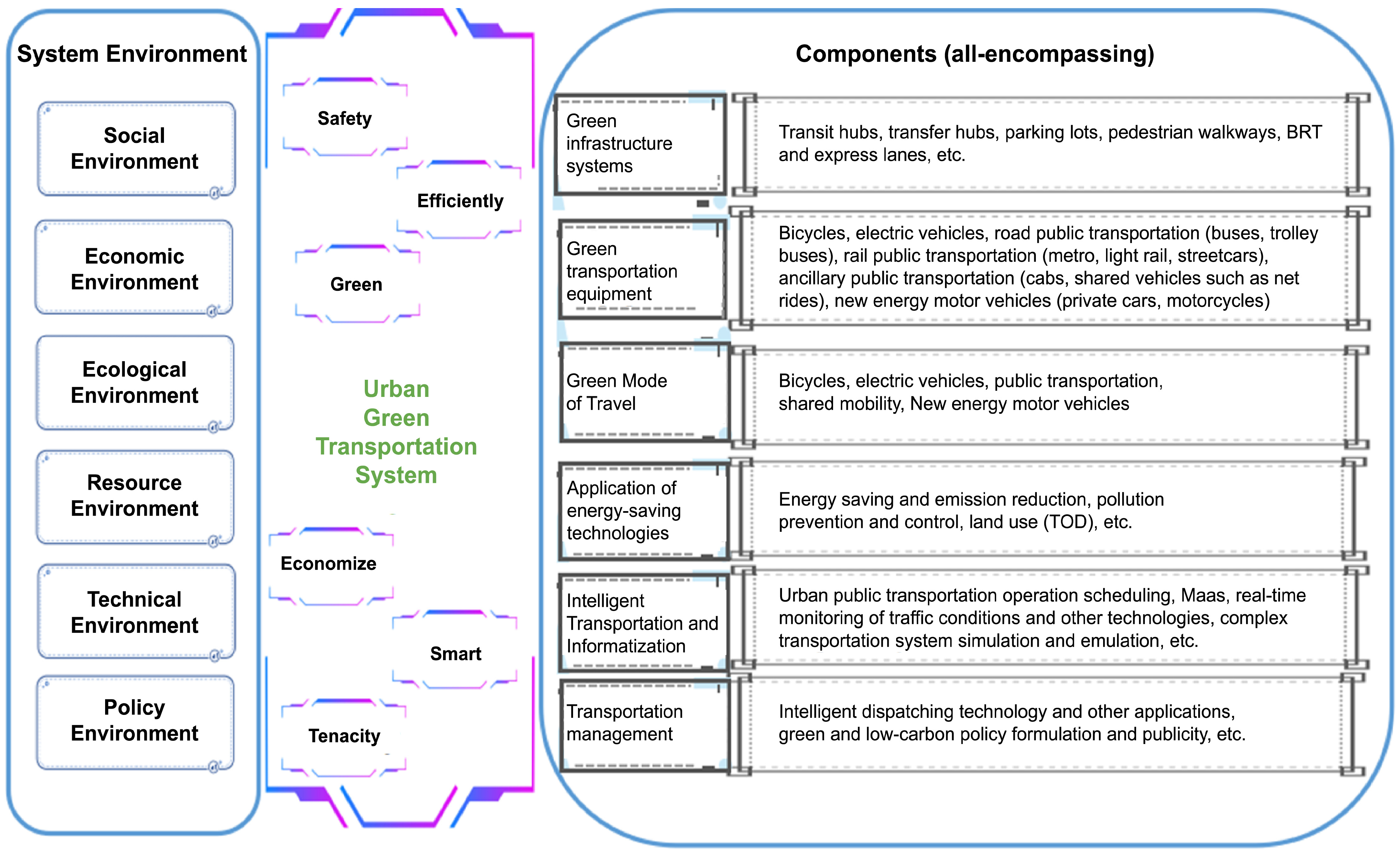
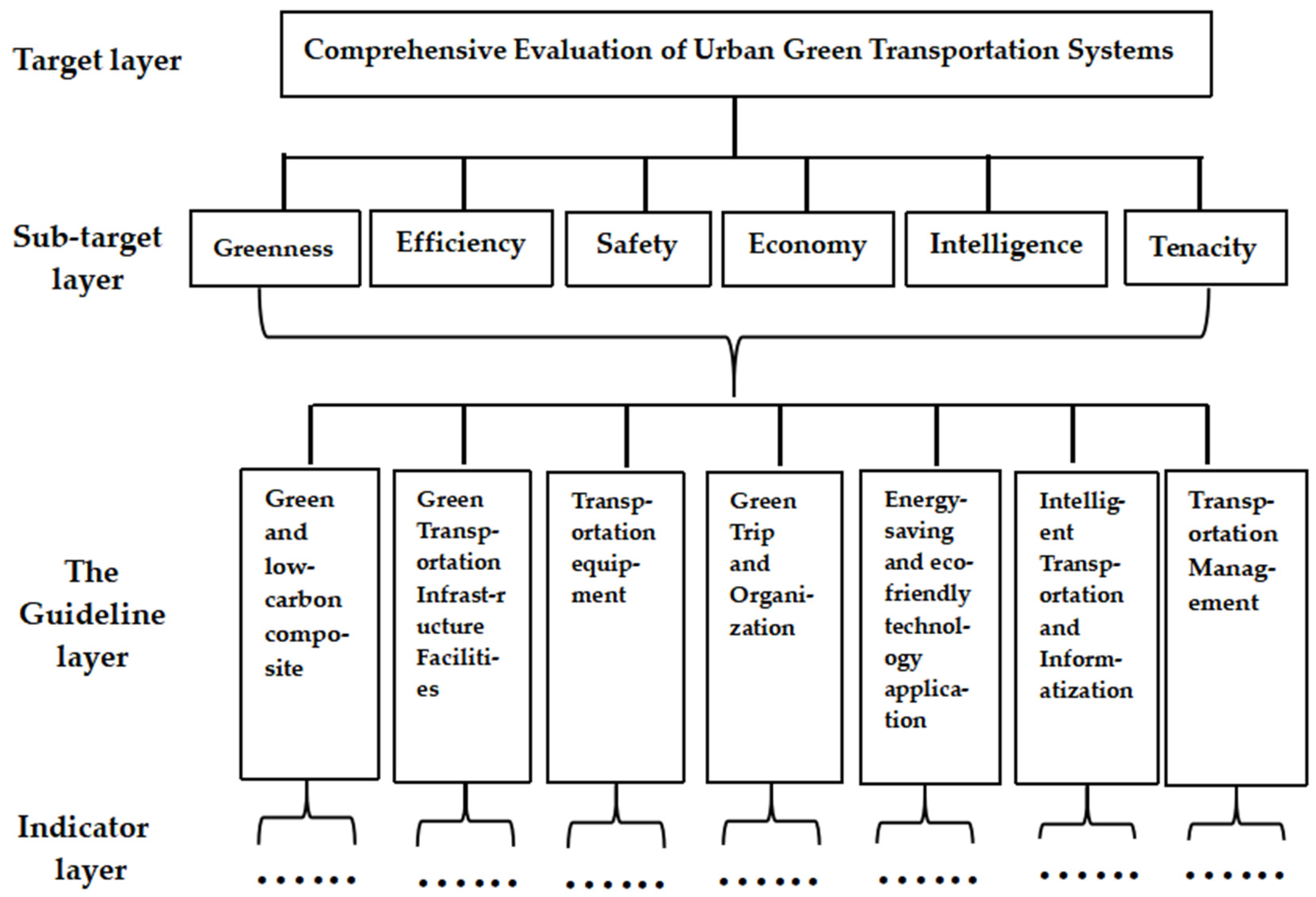
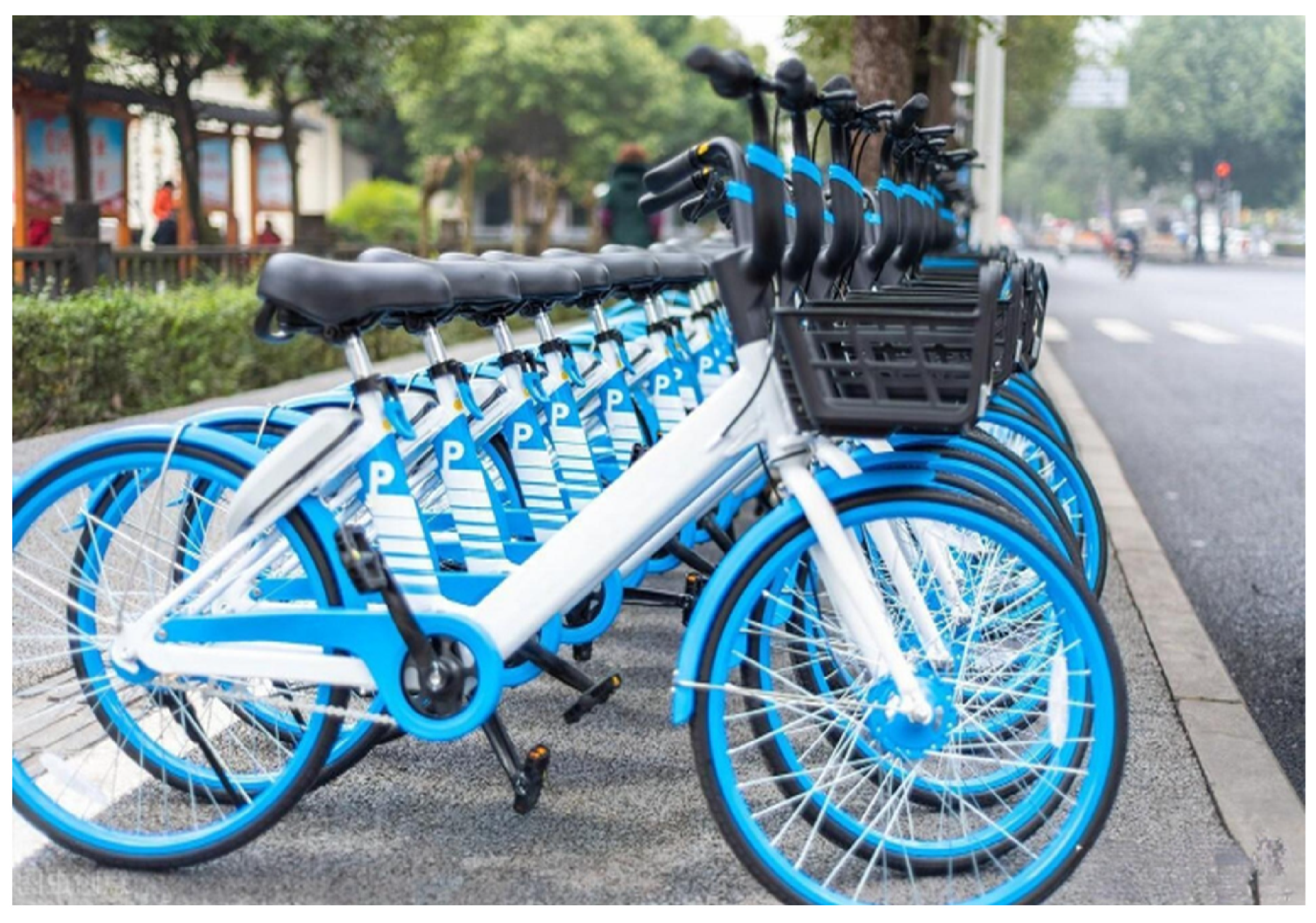
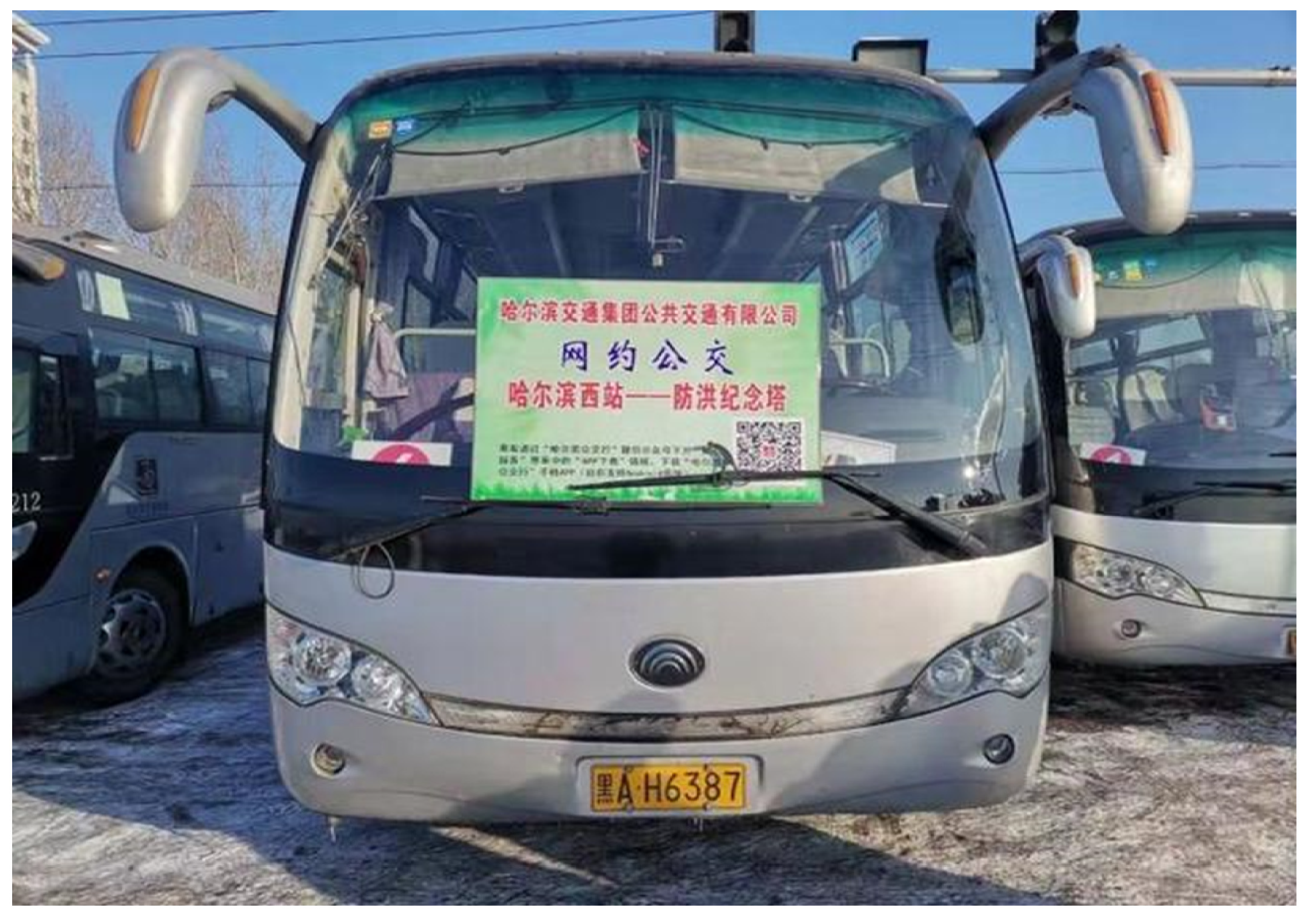
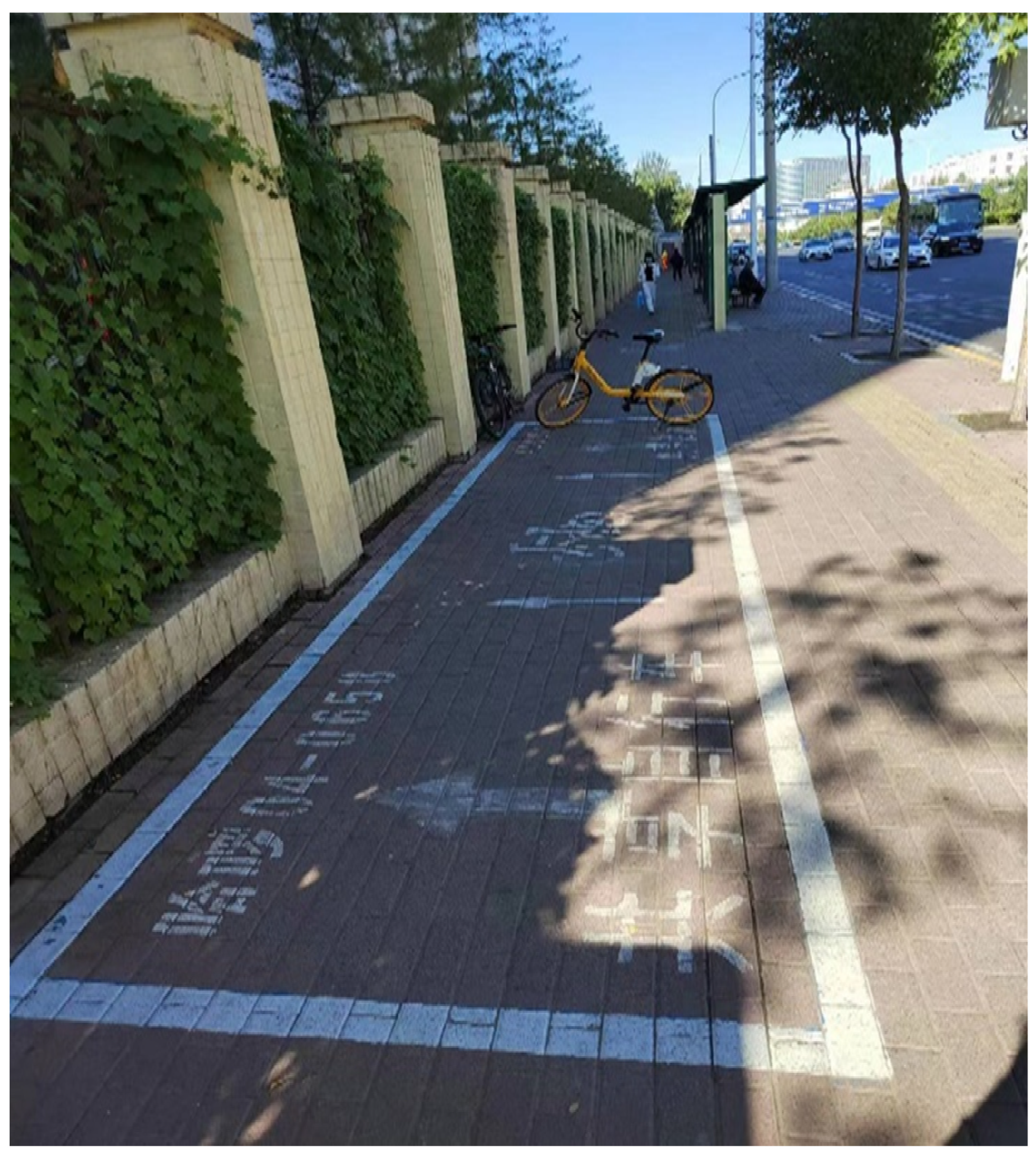
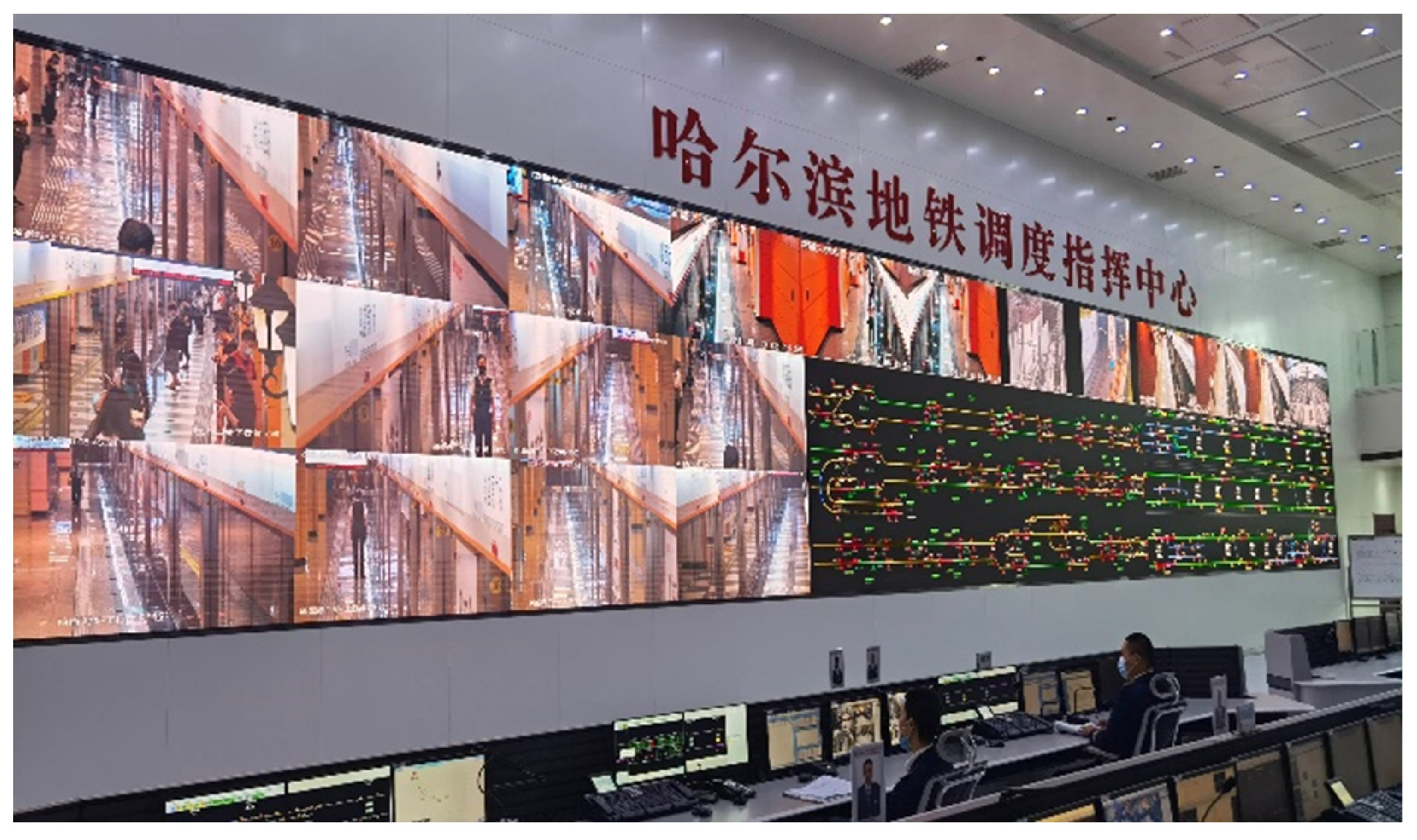
| Indicator Layer | Embodied Connotation(s) |
|---|---|
| Energy consumption per unit of transport turnover of operational vehicles (A1) | Greenness Efficiency |
| Comprehensive energy consumption per unit of transportation turnover of urban buses (A2) | Greenness Efficiency |
| Comprehensive energy consumption per unit of transportation turnover of urban rental cars (A3) | Greenness Efficiency |
| Carbon dioxide emissions per unit of transport of operational vehicles (A4) | Greenness |
| Carbon dioxide emissions per unit of passenger traffic on urban buses (A5) | Greenness |
| Carbon dioxide emissions per unit of passenger transportation for urban rental cars (A6) | Greenness |
| Reduction rate of emission intensity of major pollutants (A7) | Greenness |
| Indicator Layer | Embodied Connotation |
|---|---|
| Share of energy-saving green operating vehicles in operating vehicles (%) (C1) | Greenness Efficiency |
| Number of standardized buses per 10,000 people (standardized buses per 10,000 people) (C2) | Efficiency |
| Indicator Layer | Embodied Connotation |
|---|---|
| Density of municipal bus network (km/km2) (B1) | Efficiency |
| Bus stop coverage (500 m) (%) (B2) | Efficiency |
| Urban Bus Rapid Transit (BRT) miles per 10,000 population (including bus lanes and rail transit) (km per 10,000 population) (B3) | EFFICIENCY TENACITY |
| Construction of urban bicycle lanes (B4) | Efficiency Safety |
| Construction of urban pedestrian walkways (B5) | Efficiency |
| Operational efficiency of urban traffic signals (B6) | Safety |
| Construction of natural-gas-filling and charging stations (B7) | Efficiency |
| Construction of integrated urban transportation hubs (B8) | Efficiency Tenacity |
| Indicator Layer | Embodied Connotation |
|---|---|
| Degree of land-use alignment (E1) | Greenness Tenacity |
| Energy-saving and emission-reduction technology promotion (E2) | Greenness |
| Application of public transportation-oriented development concepts in urban planning (E3) | Tenacity |
| Indicator Layer | Embodied Connotation |
|---|---|
| Public transport travel sharing rate (%) | Greenness |
| Proportion of slow-moving transportation trips (%) (D2) | Greenness |
| Ratio of bus routes full/empty throughout day (%) (D3) | Greenness |
| Public transport punctuality (%) (D4) | Economy |
| Cab mileage utilization rate (%) (D5) | Economy |
| Development of ride-share transportation (D6) | Economy |
| Promotion of public bicycles (D7) | Economy Greenness |
| Traffic congestion index/running speed (D8) | Economy |
| 10,000-vehicle accident rate (%) (D9) | Safety |
| Average interchange coefficient (%) (D10) | Efficiency |
| Indicator Layer | Embodied Connotation |
|---|---|
| Public travel information service system application (F1) | Intelligence |
| Application of intelligent dispatch system for urban buses and taxis (F2) | Intelligence |
| Indicator Layer | Embodied Connotation |
|---|---|
| Public travel satisfaction rate (%) (G1) | Tenacity |
| Level 1 | Level 2 | Level 3 | Level 4 | Level 5 | |
|---|---|---|---|---|---|
| A7 | [9, 10] | [8, 9) | [7, 8) | [6, 7) | <6 |
| B1 | ≥4.0 | [3.3, 4.0) | [2.6, 3.3) | [1.9, 2.6) | <1.9 |
| B2 | ≥90 | [85, 90) | [80, 85) | [70, 80) | <70 |
| B4 | ≥8.0 | [7.2, 8.0) | [6.4, 7.2) | [5.6, 6.4) | <5.6 |
| B5 | ≥8.0 | [7.2, 8.0) | [6.4, 7.2) | [5.6, 6.4) | <5.6 |
| C1 | ≥50 | [45, 50) | [40, 45) | [35, 40) | [30, 35] |
| C2 | ≥18 | [14, 18) | [10, 14) | [6, 10) | <6 |
| D1 | ≥40 | [35, 40) | [30, 35) | [25, 30) | <25 |
| D8 | ≥30 | [25, 30) | [20, 25) | [15, 20) | <15 |
| D9 | ≤30 | [31, 600 | [61, 100) | [101, 150) | ≥150 |
| D10 | [1.0, 1.1) | [1.1, 1.2) | [1.2, 1.4) | [1.4, 1.5) | ≥1.5 |
| E1 | [9.10] | [8, 9) | [7, 8) | [6, 7) | <6 |
| G1 | ≥80 | [75, 80) | [65, 70) | [60, 65) | <60 |
| rk | Description |
|---|---|
| 1.0 | Indicator is as important as indicator |
| 1.2 | Indicator is slightly more important than indicator |
| 1.4 | Indicator is significantly more important than indicator |
| 1.6 | Strong importance of indicator compared to indicator |
| 1.8 | Extreme importance of indicator compared to indicator |
| i | xi | ri | wi | pj | |
|---|---|---|---|---|---|
| 1 | B1 | / | 0.2149 | 0.1492 | 0.1492 |
| 2 | B2 | 1.2 | 0.1791 | 0.1492 | 0.1492 |
| 3 | C1 | 1.0 | 0.1791 | 0.1791 | 0.1791 |
| 4 | C2 | 1.2 | 0.1492 | 0.1791 | 0.1791 |
| 5 | D1 | 1.0 | 0.1492 | 0.2149 | 0.2149 |
| 6 | D10 | 1.4 | 0.1066 | 0.1066 | 0.1066 |
| 7 | E1 | 1.6 | 0.0666 | 0.0666 | 0.0666 |
| No. | Evaluation Indicator | Harbin Actual Value | Rating Levels | Score | ||||
|---|---|---|---|---|---|---|---|---|
| 1 | 2 | 3 | 4 | 5 | ||||
| 1 | B1 | 2.82 | √ | 3 | ||||
| 2 | B2 | 99.7 | √ | 5 | ||||
| 3 | C1 | 94 | √ | 5 | ||||
| 4 | C2 | 13 | √ | 3 | ||||
| 5 | D1 | 56.2 | √ | 5 | ||||
| 6 | D10 | 1.28 | √ | 3 | ||||
| 7 | E1 | 6.9 | √ | 2 | ||||
| Sj | ||||||
|---|---|---|---|---|---|---|
| 1 | B1 | 3 | 0.1154 | 0.0997 | 0.9003 | 0.1442 |
| 2 | B2 | 5 | 0.1923 | 0.1268 | 0.8732 | 0.1399 |
| 3 | C1 | 5 | 0.1923 | 0.1268 | 0.8732 | 0.1399 |
| 4 | C2 | 3 | 0.1154 | 0.0997 | 0.9003 | 0.1442 |
| 5 | D1 | 5 | 0.1923 | 0.1268 | 0.8732 | 0.1399 |
| 6 | D10 | 3 | 0.1154 | 0.0997 | 0.9003 | 0.1442 |
| 7 | E1 | 2 | 0.0769 | 0.0789 | 0.9211 | 0.1476 |
| 1 | B1 | 0.1492 | 0.1442 | 0.1467 |
| 2 | B2 | 0.1492 | 0.1399 | 0.1446 |
| 3 | C1 | 0.1791 | 0.1399 | 0.1595 |
| 4 | C2 | 0.1791 | 0.1442 | 0.1617 |
| 5 | D1 | 0.2149 | 0.1399 | 0.1774 |
| 6 | D10 | 0.1066 | 0.1442 | 0.1254 |
| 7 | E1 | 0.0666 | 0.1476 | 0.1071 |
Disclaimer/Publisher’s Note: The statements, opinions and data contained in all publications are solely those of the individual author(s) and contributor(s) and not of MDPI and/or the editor(s). MDPI and/or the editor(s) disclaim responsibility for any injury to people or property resulting from any ideas, methods, instructions or products referred to in the content. |
© 2024 by the authors. Licensee MDPI, Basel, Switzerland. This article is an open access article distributed under the terms and conditions of the Creative Commons Attribution (CC BY) license (https://creativecommons.org/licenses/by/4.0/).
Share and Cite
Deng, C.; Shi, Z.; Chi, B.; Wang, J. Evaluating the Development Levels of Green Urban Transportation Systems. Sustainability 2024, 16, 4795. https://doi.org/10.3390/su16114795
Deng C, Shi Z, Chi B, Wang J. Evaluating the Development Levels of Green Urban Transportation Systems. Sustainability. 2024; 16(11):4795. https://doi.org/10.3390/su16114795
Chicago/Turabian StyleDeng, Chunyao, Zhenwu Shi, Bo Chi, and Jinru Wang. 2024. "Evaluating the Development Levels of Green Urban Transportation Systems" Sustainability 16, no. 11: 4795. https://doi.org/10.3390/su16114795
APA StyleDeng, C., Shi, Z., Chi, B., & Wang, J. (2024). Evaluating the Development Levels of Green Urban Transportation Systems. Sustainability, 16(11), 4795. https://doi.org/10.3390/su16114795





